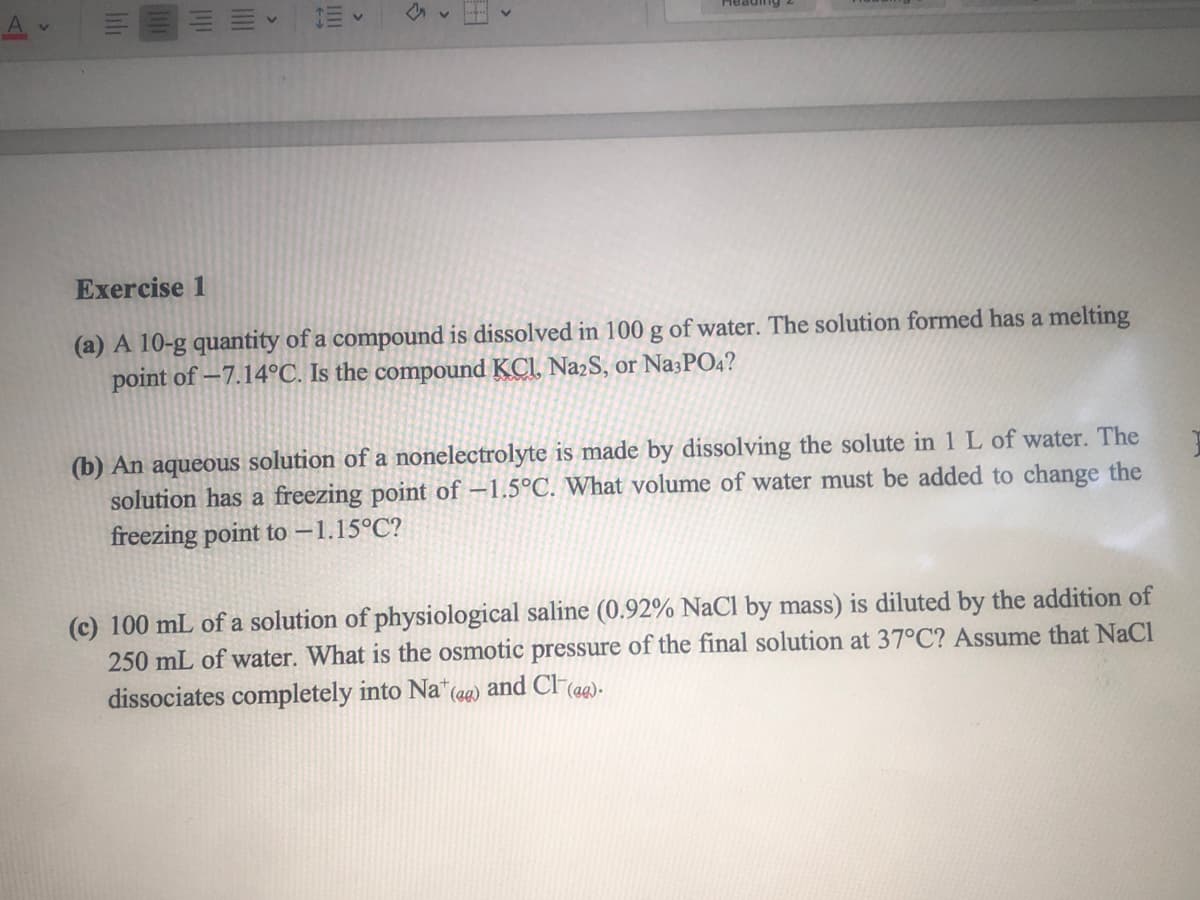(b) An aqueous solution of a nonelectrolyte is made by dissolving the solute in 1 L of water. The solution has a freezing point of –1.5°C. What volume of water must be added to change the freezing point to -1.15°C?
(b) An aqueous solution of a nonelectrolyte is made by dissolving the solute in 1 L of water. The solution has a freezing point of –1.5°C. What volume of water must be added to change the freezing point to -1.15°C?
Chemistry: An Atoms First Approach
2nd Edition
ISBN:9781305079243
Author:Steven S. Zumdahl, Susan A. Zumdahl
Publisher:Steven S. Zumdahl, Susan A. Zumdahl
Chapter10: Properties Of Solutions
Section: Chapter Questions
Problem 5ALQ: You have read that adding a solute to a solvent can both increase the boiling point and decrease the...
Related questions
Question
100%
Question b

Transcribed Image Text:neading
Exercise 1
(a) A 10-g quantity of a compound is dissolved in 100 g of water. The solution formed has a melting
point of -7.14°C. Is the compound KCl, Na2S, or Na3PO4?
(b) An aqueous solution of a nonelectrolyte is made by dissolving the solute in 1 L of water. The
solution has a freezing point of –1.5°C. What volume of water must be added to change the
freezing point to -1.15°C?
(c) 100 mL of a solution of physiological saline (0.92% NaCl by mass) is diluted by the addition of
250 mL of water. What is the osmotic pressure of the final solution at 37°C? Assume that NaCl
dissociates completely into Na"(ag)
and Cl-
(ag).
lili
Expert Solution
This question has been solved!
Explore an expertly crafted, step-by-step solution for a thorough understanding of key concepts.
Step by step
Solved in 2 steps with 1 images

Knowledge Booster
Learn more about
Need a deep-dive on the concept behind this application? Look no further. Learn more about this topic, chemistry and related others by exploring similar questions and additional content below.Recommended textbooks for you

Chemistry: An Atoms First Approach
Chemistry
ISBN:
9781305079243
Author:
Steven S. Zumdahl, Susan A. Zumdahl
Publisher:
Cengage Learning


Chemistry
Chemistry
ISBN:
9781305957404
Author:
Steven S. Zumdahl, Susan A. Zumdahl, Donald J. DeCoste
Publisher:
Cengage Learning

Chemistry: An Atoms First Approach
Chemistry
ISBN:
9781305079243
Author:
Steven S. Zumdahl, Susan A. Zumdahl
Publisher:
Cengage Learning


Chemistry
Chemistry
ISBN:
9781305957404
Author:
Steven S. Zumdahl, Susan A. Zumdahl, Donald J. DeCoste
Publisher:
Cengage Learning

Chemistry & Chemical Reactivity
Chemistry
ISBN:
9781133949640
Author:
John C. Kotz, Paul M. Treichel, John Townsend, David Treichel
Publisher:
Cengage Learning

Chemistry & Chemical Reactivity
Chemistry
ISBN:
9781337399074
Author:
John C. Kotz, Paul M. Treichel, John Townsend, David Treichel
Publisher:
Cengage Learning

Introduction to General, Organic and Biochemistry
Chemistry
ISBN:
9781285869759
Author:
Frederick A. Bettelheim, William H. Brown, Mary K. Campbell, Shawn O. Farrell, Omar Torres
Publisher:
Cengage Learning